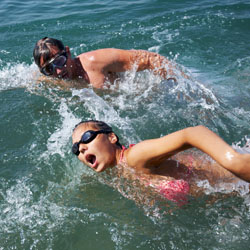Microbiological and Chemical Exposure Assessment: Water

Given water’s fundamental importance to human life, it’s crucial for scientists to understand how we might be exposed to microbial and chemical threats in our drinking water systems and recreational waters. EPA researchers are studying ways that microbes and chemicals can travel through and grow in groundwater, drinking water, and recreational water. They are developing new methods for detecting viruses in drinking water, unregulated chemicals and other contaminants in drinking and groundwater, and bacteria in recreational water and plumbing systems, which can be used by water managers across the country to ensure that both drinking and recreational waters are safe.
Using mussels to detect microbial contamination of ambient water
Mussels, oysters, clams, scallops and other bivalves are efficient natural filters that can "clean" up to five liters of water per hour while they feed on microscopic plants and nutrients in water. EPA scientists are taking advantage of this ability by developing a low cost, effective concentration method using native and invasive species, like blue mussels and Asian clams to collect an array of microbial pathogens from water.
Sample preparation techniques for concentrating microbes from water
Pathogenic microbes can potentially pose a risk to public health, even when they are present at very low levels in the environment. To know what microbes are present in a given water matrix, methods are needed that will effectively remove most of the water while retaining microbes in a given sample. EPA scientists are investigating several alternative approaches separating microbes from water more effectively. They are also evaluating techniques that allow different types of microbes, such as viruses, parasites, and bacteria to be isolated. This work has resulted in the identification of low cost alternative sample concentration techniques.
How common are contaminants in treated and untreated drinking water?
Drinking water has the potential to contain traces of unregulated contaminants like perfluorinated alkyl substances (PFAS), algal toxins and heavy metals. To develop strategies for protecting human health, EPA needs to understand the prevalence of these contaminants in both treated and untreated drinking water. Improvements in analytical instrumentation now allow scientists to measure pollutants at very low concentrations. EPA scientists are conducting research to understand just how common these contaminants are.
Saliva-based measurement method for detecting exposure to waterborne pathogens
Exposure scientists at EPA have developed a quick, inexpensive method to sample swimmers’ saliva to understand the links between exposure to pathogens in water and human health. Using swabs of saliva, which can be collected quickly and non-invasively, scientists can look at specific antibodies created by the immune system in response to exposure to certain microbes.
